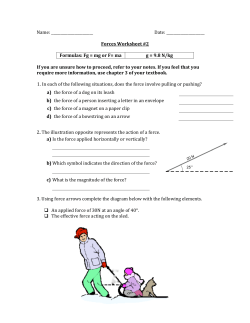
Phys121_05
velocity dx / dt dr v dy / dt ; dt dz / dt p m v ; momentum impulse dp [dp] A [dp]B [dp]C ... Force [dp ] A FA dt Weight Fg m g Total Momentum ptot p1 p2 p3 ... System’s Center Of Mass Motion of COM rCM m1 r1 m2 r2 m3 r3 ... M M vCM m1 v1 m2 v2 m3v3 ... ptot Internal versus external interactions. No external interactions ptot conserved Inertial frames of reference: Not accelerated (not rotating or any other kind of accel…) C4R.1 A 56-kg canoeist sits at rest at the back end of a 23-kg canoe. The canoe is at rest in the still water of a lake with its front end about 0.50 m from the dock. The canoeist realizes that she has left the paddle on the dock, so she carefully works her way to the front of the 3.8-m canoe. Is she likely to be able to reach the dock from the front of the boat? A.Yes; B.No; x=3.2 m C.Mmmmmhhhh….. I don’t know. Translation: Given xi, L, mperson, mcanoe, calculate xf What remains constant? No external forces Center of Mass fixed. C5T.7 Two hockey pucks are sliding on a flat, horizontal plane of frictionless ice. One puck has twice the mass of the other. They approach each other, collide, and stick together. Initially the light puck is moving east at 3 m/s and the heavy puck is moving west at 2 m/s. The final velocity of the joined puck is: A.Eastward; B.Westward; C.Zero; D.Impossible to determine. C5T.8 Two hockey pucks are sliding on a flat, horizontal plane of frictionless ice. One puck has twice the mass of the other. They approach each other, collide, and stick together. Initially the light puck is moving west at 4 m/s and the heavy puck is moving south at 2 m/s. The final velocity of the joined puck is: A.Northeast; B.Northwest; C.Southeast; D.Southwest; E.Zero. C5T.9 Two hockey pucks are sliding on a flat, horizontal plane of frictionless ice. One puck has twice the mass of the other. They approach each other, collide, and stick together. Initially the light puck is moving south and the final speed of the joined pucks is zero. The original Velocity of the heavy puck must have been nortward: A.True; B.False; C.I don’t know. C5R.1 A small asteroid of mass 2.6×109 kg is discovered traveling at a speed of 18 km/s on a direct heading for Starbase Alpha, which is in deep space well outside the solar system. Lacking weapons of sufficient power to destroy the asteroid, the frightened starbase inhabitants decide to deflect it by hitting it with a remotecontrolled spaceship. The spaceship has an empty mass of 25,000 kg and a top speed of 85 km/s when its fuel is exhausted. The asteroid has to be deflected so that by the time it reaches the starbase, its center is 1800 m away from its original path. What is the minimum distance before the asteroid’s projected impact that the spaceship must reach the asteroid? A. B. C. D. 4×103 m; 4×105 m; 4×107 m; 4×109 m. C5A.1 Consider a rocket in deep space whose empty mass is 5200 kg that can carry 52,000 kg of propellant. If the rocket engine can eject 1300 kg/s of propellant from its nozzle at a speed of 3300 m/s relative to the rocket, and if the rocket starts at rest, what is its approx. final speed? A. B. C. D. 102 m/s; 104 m/s; 106 m; 108 m.
© Copyright 2025
















